engine Acura RSX 2002 Owner's Guide
[x] Cancel search | Manufacturer: ACURA, Model Year: 2002, Model line: RSX, Model: Acura RSX 2002Pages: 320, PDF Size: 4.38 MB
Page 162 of 320
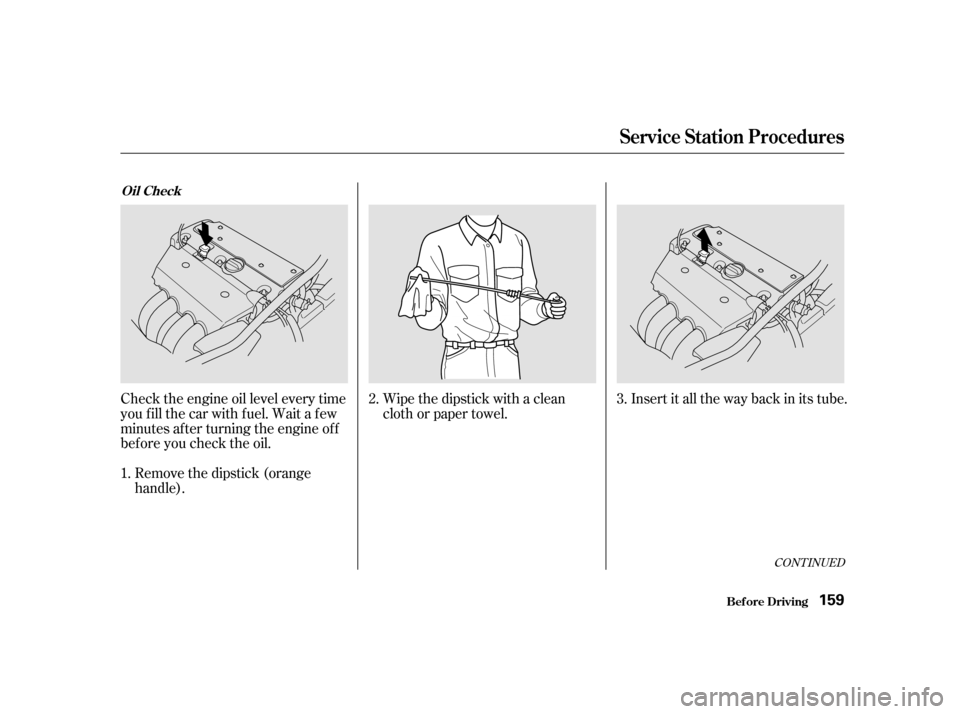
Wipe the dipstick with a clean
cloth or paper towel.Insert it all the way back in its tube.
Remove the dipstick (orange
handle).
Check the engine oil level every time
you f ill the car with f uel. Wait a f ew
minutes af ter turning the engine of f
bef ore you check the oil.
2.
3.
1.
CONT INUED
Oil Check
Service Station Procedures
Bef ore Driving159
Page 163 of 320
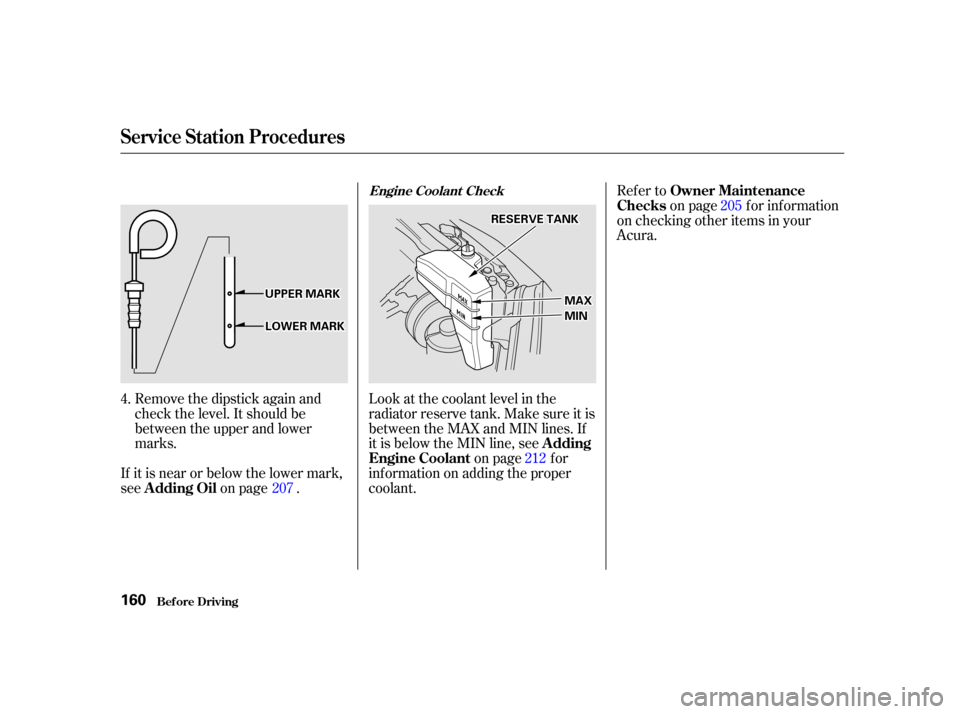
Remove the dipstick again and
check the level. It should be
between the upper and lower
marks.Look at the coolant level in the
radiator reserve tank. Make sure it is
between the MAX and MIN lines. If
it is below the MIN line, see
on page f or
inf ormation on adding the proper
coolant. Refer to
on page f or inf ormation
on checking other items in your
Acura.
If it is near or below the lower mark,
see on page .
4.
207 205
212
Engine Coolant Check
A dding
Engine Coolant Owner Maintenance
Checks
A dding Oil
Service Station Procedures
Bef ore Driving160
U UP PP
PE
ER
R M
M A
AR
RKK
M
MI
INN
M
M
A
AX
X
L
LO OW WE ER
R M
M A
AR
RKK R
RE
ES
SE ER
RV V E
E T
TA
A N
NK K
Page 164 of 320

A cold engine uses more f uel than a
warm engine. It is not necessary to
‘‘warm-up’’ a cold engine by letting it
idle f or a long time. You can drive
away in about a minute, no matter
how cold it is outside. The engine
will warm up f aster, and you get
better f uel economy. To cut down on
the number of ‘‘cold starts,’’ try to
combine several short trips into one.
You can improve f uel economy by
driving moderately. Rapid acceler-
ation, abrupt cornering, and hard
braking use more f uel.
Always drive in the highest gear that
allows the engine to run and acceler-
ate smoothly.
The air conditioning puts an extra
load on the engine which makes it
usemorefuel.Turnoff theA/Cto
cutdownonairconditioninguse.
Use the f low-through ventilation
when the outside air temperature is
moderate.
Always maintain your car according
to the maintenance schedule. This
will keep it in top operating condition.
An important part of that mainte-
nance is the
(see page ). For
example, an underinf lated tire
causes more ‘‘rolling resistance,’’
which uses f uel. It also wears out
f aster, so check the tire pressure at
least monthly.
In winter, the build-up of snow on
your car’s underside adds weight and
rolling resistance. Frequent cleaning
helps your f uel mileage and reduces
thechanceof corrosion. Depending on traf f ic conditions, try
to maintain a constant speed. Every
time you slow down and speed up,
your car uses extra f uel. Use the
cruise control, when appropriate, to
increase f uel economy.
The condition of your car and your
driving habits are the two most
important things that affect the fuel
mileage you get.
205
Vehicle Condition
Driving Habits
Owner Maintenance
Checks
Bef ore Driving
Fuel Economy
161
Page 170 of 320

This section gives you tips on
starting the engine under various
conditions, and how to operate the
5-speed and 6-speed manual
transmissions and automatic
transmission. It also the includes
important inf ormation on parking
your car, the braking system, and
f acts you need if you are planning to
tow a trailer.........................
Preparing to Drive .168
.......................
Starting the Engine .169
Starting in Cold Weather ....................
at High Altitude .169
5-speed and 6-speed .........
Manual Transmissions . 170
.....
Recommended Shif t Points . 171
..............
Engine Speed Limiter . 171
.......................
Reverse Lockout .172
..............
Automatic Transmission . 173
.
Shif t Lever Position Indicator . 173
................
Shif t Lever Positions . 173
..............
Engine Speed Limiter . 178
....................
Shif t Lock Release . 179
...........................................
Parking .180
.....................
The Braking System .181
.............
Brake Wear Indicators . 181
...............
Brake System Design . 182
.......................
Anti-lock Brakes .182
Important Saf ety .........................
Reminders .183
........................
ABS Indicator .183
...............
Driving in Bad Weather . 184
...........................
Towing a Trailer .186
Driving
Driving167
Page 171 of 320

Make sure all windows, mirrors,
and outside lights are clean and
unobstructed. Remove f rost, snow,
or ice.Check the adjustment of the seat
(see page ).
Check the adjustment of the
inside and outside mirrors (see
page ).
Check the adjustment of the
steering wheel (see page ).
Fasten your seat belt. Check that
your passengers have f astened
their seat belts (see page ).Turn the ignition switch ON (II).
Check the indicator lights in the
instrument panel.
Start the engine (see page ).
Check the gauges and indicator
lights in the instrument panel (see
page ).
Check that the hood and hatch are
f ully closed.
Visually check the tires. If a tire
looks low, use a gauge to check its
pressure.
Check that any items you may be
carrying with you inside are stored
properly or f astened down
securely.
Youshoulddothefollowingchecks
and adjustments every day bef ore
you drive your car.
Make sure the doors and hatch
are securely closed and locked.
1.
2.
3.
9. 8.
7. 6. 5.
4. 10.
11.
12.
16
86
95 74 169
59
Preparing to Drive
Driving168
Page 172 of 320

If the engine does not start within
15 seconds, or starts but stalls
right away, repeat step 4 with the
accelerator pedal pressed half-way
down. If the engine starts, release
pressure on the accelerator pedal
so the engine does not race.
If the engine still does not start,
press the accelerator pedal all the
way down and hold it there while
starting in order to clear f looding.
As bef ore, keep the ignition key in
the START (III) position f or no
more than 15 seconds. Return to
step 5 if the engine does not start.
If it starts, lif t your f oot of f the
accelerator pedal so the engine
does not race.
Apply the parking brake.
In cold weather, turn of f all
electrical accessories to reduce
the drain on the battery.
Without touching the accelerator
pedal, turn the ignition key to the
START (III) position. If the engine
does not start right away, do not
hold the key in START (III) f or
more than 15 seconds at a time.
Pause f or at least 10 seconds
bef ore trying again.
An engine is harder to start in cold
weather. The thinner air f ound at
high altitude above 8,000 f eet (2,400 meters) adds to the problem.
Use the f ollowing procedure:
Turn of f all electrical accessories
to reduce the drain on the battery.
Push the accelerator pedal half-
way to the f loor and hold it there
while starting the engine. Do not
hold the ignition key in START
(III) f or more than 15 seconds.
When the engine starts, release
the accelerator pedal gradually as
the engine speeds up and smooths
out.
If the engine fails to start in step 2,
push the accelerator pedal to the
f loor and hold it there while you
try to start the engine for no more
than 15 seconds. If the engine
does not start, return to step 2.
Push the clutch pedal down all the
way. START (III) does not
f unction unless the clutch pedal is
depressed.
Make sure the shif t lever is in
Park. Press on the brake pedal.
1.
2.
3.
4. 5.
6.
1.
2.
3.
Manual Transmission:
Automatic Transmission:
Starting the Engine
Driving
Starting in Cold Weather at High
A ltitude (A bove 8,000 f eet/
2,400 meters)
169
Page 173 of 320
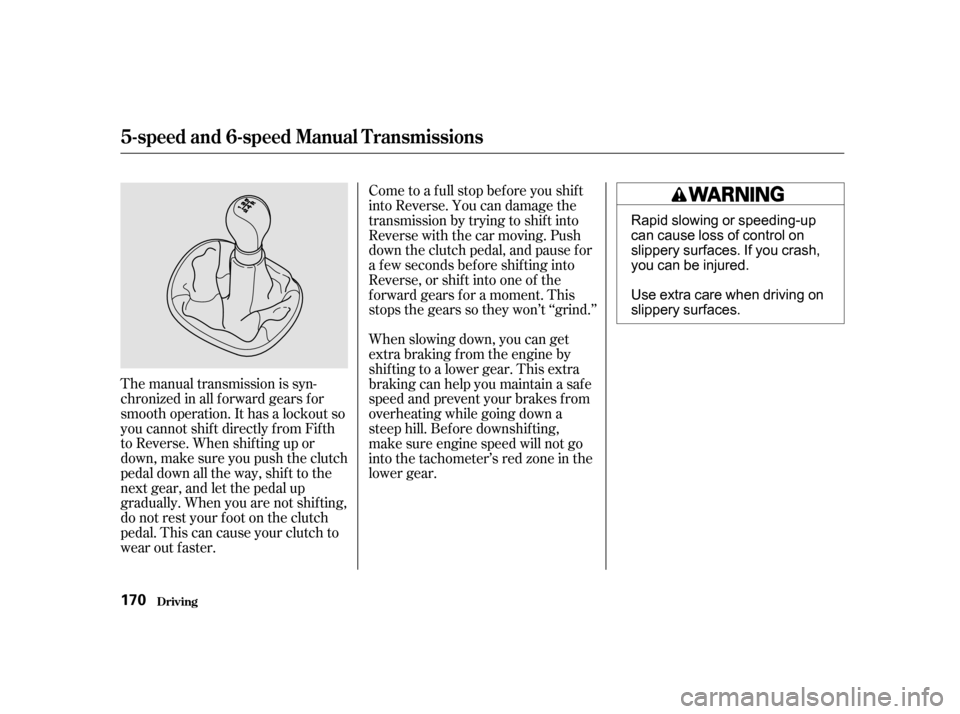
The manual transmission is syn-
chronizedinallforwardgearsfor
smooth operation. It has a lockout so
you cannot shift directly from Fifth
to Reverse. When shif ting up or
down,makesureyoupushtheclutch
pedal down all the way, shift to the
next gear, and let the pedal up
gradually. When you are not shif ting,
do not rest your f oot on the clutch
pedal. This can cause your clutch to
wear out faster.When slowing down, you can get
extra braking f rom the engine by
shifting to a lower gear. This extra
braking can help you maintain a safe
speed and prevent your brakes f rom
overheating while going down a
steep hill. Bef ore downshif ting,
make sure engine speed will not go
into the tachometer’s red zone in the
lower gear. Come to a full stop before you shift
into Reverse. You can damage the
transmission by trying to shift into
Reverse with the car moving. Push
down the clutch pedal, and pause f or
a f ew seconds bef ore shif ting into
Reverse, or shif t into one of the
f orward gears f or a moment. This
stops the gears so they won’t ‘‘grind.’’
Driving
5-speed and 6-speed Manual T ransmissions
170
Rapid slowing or speeding-up
can cause loss of control on
slippery surfaces. If you crash,
you can be injured.
Use extra care when driving on
slippery surfaces.
Page 174 of 320

Drive in the highest gear that lets
the engine run and accelerate
smoothly. This will give you the best
f uel economy and ef f ective emis-
sions control. The f ollowing shif t
points are recommended:If you exceed the maximum speed
f or the gear you are in, the engine
speed will enter into the tachometer’s
red zone. If this occurs, you may f eel
the engine cut in and out. This is
caused by a limiter in the engine’s
computer controls. The engine will
run normally when you reduce the
RPM below the red zone.
Bef ore downshif ting, make sure the
engine will not go into the
tachometer’s red zone.
Shif t up
1st to 2nd
2nd to 3rd 3rd to 4th4th to 5th 7mph(11km/h)
23 mph (37 km/h)
33 mph (53 km/h)
45 mph (72 km/h)
Shif t up
1st to 2nd
2nd to 3rd 3rd to 4th4th to 5th Normal acceleration
14 mph (23 km/h)
25 mph (40 km/h)
40 mph (64 km/h)
49 mph (79 km/h)
Shif t up
1st to 2nd
2nd to 3rd 3rd to 4th4th to 5th
5th to 6th Normal acceleration
14 mph (23 km/h)
25 mph (40 km/h)
40 mph (64 km/h)
49 mph (79 km/h)
54 mph (87 km/h) Shif t up
1st to 2nd
2nd to 3rd 3rd to 4th4th to 5th
5th to 6th 7mph(11km/h)
23 mph (37 km/h)
33 mph (53 km/h)
45 mph (72 km/h)
50 mph (80 km/h)
Cruise from acceleration
Cruise from acceleration
5-speed 5-speed
6-speed 6-speed
Driving
Recommended Shif t Points
Engine Speed L imiter
5-speed and 6-speed Manual T ransmissions
171
Page 175 of 320
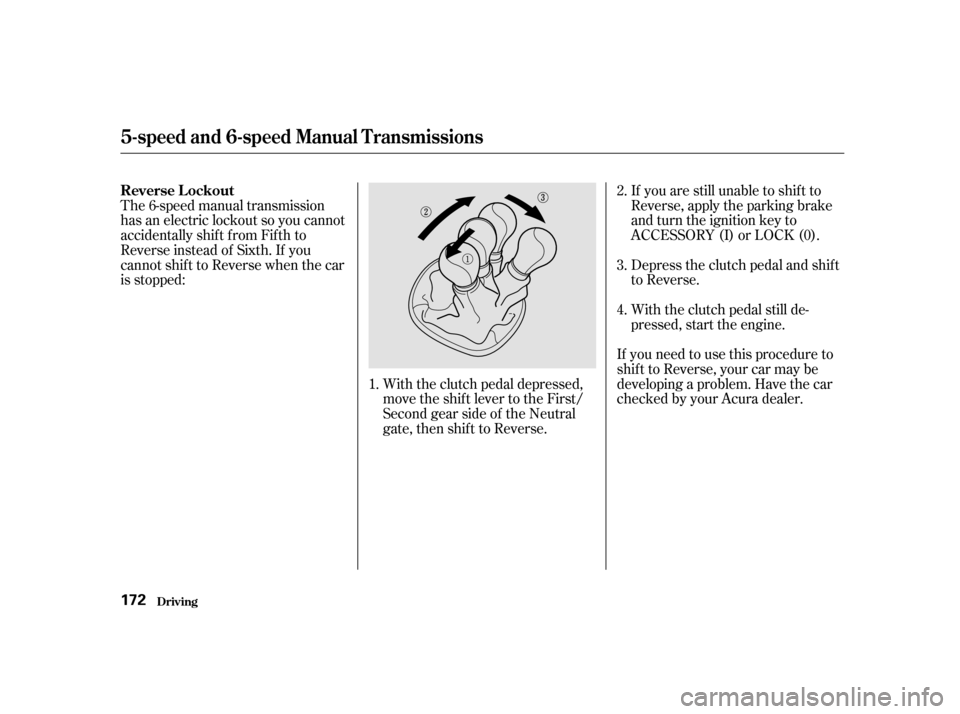
The 6-speed manual transmission
has an electric lockout so you cannot
accidentally shif t f rom Fif th to
Reverse instead of Sixth. If you
cannot shif t to Reverse when the car
is stopped:If you are still unable to shif t to
Reverse, apply the parking brake
andturntheignitionkeyto
ACCESSORY (I) or LOCK (0).
Depress the clutch pedal and shif t
to Reverse.
With the clutch pedal still de-
pressed, start the engine.
If you need to use this procedure to
shif t to Reverse, your car may be
developing a problem. Have the car
checked by your Acura dealer.
With the clutch pedal depressed,
move the shift lever to the First/
Second gear side of the Neutral
gate, then shif t to Reverse.
1. 2.
3.
4.
Driving
5-speed and 6-speed Manual T ransmissions
Reverse Lockout
172
Page 176 of 320
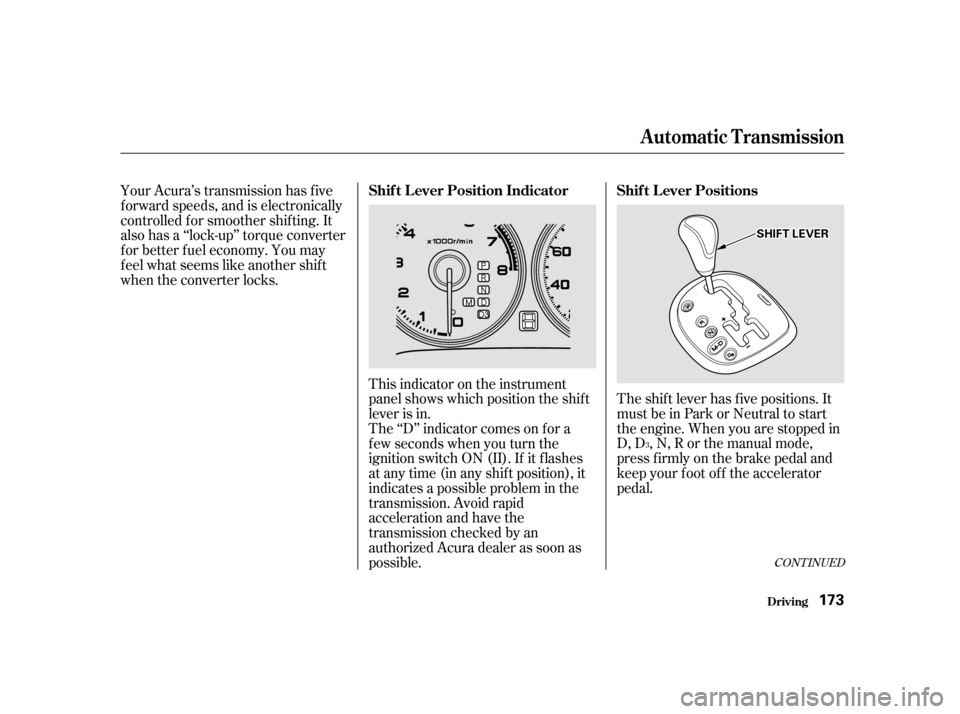
The shift lever has five positions. It
must be in Park or Neutral to start
the engine. When you are stopped in
D, D , N, R or the manual mode,
press firmly on the brake pedal and
keep your f oot of f the accelerator
pedal.
Your Acura’s transmission has f ive
f orward speeds, and is electronically
controlled f or smoother shif ting. It
also has a ‘‘lock-up’’ torque converter
forbetterfueleconomy.Youmay
f eel what seems like another shif t
when the converter locks.
This indicator on the instrument
panel shows which position the shif t
lever is in.
The ‘‘D’’ indicator comes on f or a
f ew seconds when you turn the
ignition switch ON (II). If it f lashes
at any time (in any shift position), it
indicates a possible problem in the
transmission. Avoid rapid
acceleration and have the
transmission checked by an
authorized Acura dealer as soon as
possible.
3
CONT INUED
Shif t L ever Position Indicator Shif t L ever Positions
Automatic Transmission
Driving173
S SHH I
IFFT T L
LEE V
V E
ER
R